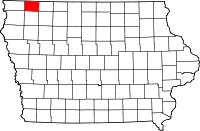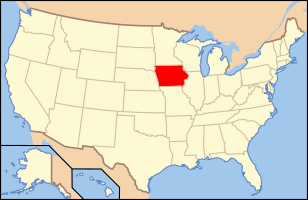Osceola County, Iowa
| Osceola County, Iowa | |
|---|---|
|
Osceola County Courthouse, July 2014 | |
 Location in the U.S. state of Iowa | |
 Iowa's location in the U.S. | |
| Founded | 1871 |
| Named for | Osceola |
| Seat | Sibley |
| Largest city | Sibley |
| Area | |
| • Total | 399 sq mi (1,033 km2) |
| • Land | 399 sq mi (1,033 km2) |
| • Water | 0.7 sq mi (2 km2), 0.2% |
| Population | |
| • (2010) | 6,462 |
| • Density | 16/sq mi (6/km2) |
| Congressional district | 4th |
| Time zone | Central: UTC−6/−5 |
| Website |
osceolacountyia |
Osceola County is a county located in the U.S. state of Iowa. As of the 2010 census, the population was 6,462.[1] It is named for Seminole war chief Osceola. The county seat is Sibley, named for H. H. Sibley of Minnesota.[2]
History
Osceola County was formed in 1871. It was named after the eponymous chief of the Seminole.[3] It is the smallest and most recent county in Iowa. In the same year the first settler arrived, Captain Eldred Huff, and laid his claim. On January 1, 1872, the county government conferred for the first time. The first courthouse, constructed of wood, was built in November of the following year and simultaneously served as the conference chamber, school and church. In September 1903, the second courthouse was finished and was wired for electricity in October, 1915.
Geography
According to the U.S. Census Bureau, the county has a total area of 399 square miles (1,030 km2), of which 399 square miles (1,030 km2) is land and 0.7 square miles (1.8 km2) (0.2%) is water.[4] It is the third-smallest county in Iowa by land area and smallest by total area. The highest natural point in Iowa, Hawkeye Point at 1,670 feet (509 m), is located in Osceola County.[5]
Major highways
Adjacent counties
- Nobles County, Minnesota (northwest)
- Jackson County, Minnesota (northeast)
- Dickinson County (east)
- O'Brien County (south)
- Lyon County (west)
Demographics
| Historical population | |||
|---|---|---|---|
| Census | Pop. | %± | |
| 1880 | 2,219 | — | |
| 1890 | 5,574 | 151.2% | |
| 1900 | 8,725 | 56.5% | |
| 1910 | 8,956 | 2.6% | |
| 1920 | 10,223 | 14.1% | |
| 1930 | 10,182 | −0.4% | |
| 1940 | 10,607 | 4.2% | |
| 1950 | 10,181 | −4.0% | |
| 1960 | 10,064 | −1.1% | |
| 1970 | 8,555 | −15.0% | |
| 1980 | 8,371 | −2.2% | |
| 1990 | 7,267 | −13.2% | |
| 2000 | 7,003 | −3.6% | |
| 2010 | 6,462 | −7.7% | |
| Est. 2016 | 6,064 | [6] | −6.2% |
| U.S. Decennial Census[7] 1790-1960[8] 1900-1990[9] 1990-2000[10] 2010-2013[1] | |||
2010 census
The 2010 census recorded a population of 6,462 in the county, with a population density of 16.2048/sq mi (6.2567/km2). There were 2,990 housing units, of which 2,682 were occupied.[11]
2000 census

As of the census[12] of 2000, there were 7,003 people, 2,778 households, and 1,941 families residing in the county. The population density was 18 people per square mile (7/km²). There were 3,012 housing units at an average density of 8 per square mile (3/km²). The racial makeup of the county was 98.04% White, 0.11% Black or African American, 0.26% Native American, 0.20% Asian, 0.01% Pacific Islander, 0.84% from other races, and 0.53% from two or more races. 1.78% of the population were Hispanic or Latino of any race.
There were 2,778 households out of which 31.70% had children under the age of 18 living with them, 62.00% were married couples living together, 5.10% had a female householder with no husband present, and 30.10% were non-families. 27.60% of all households were made up of individuals and 15.10% had someone living alone who was 65 years of age or older. The average household size was 2.48 and the average family size was 3.03.
In the county, the population was spread out with 26.10% under the age of 18, 7.20% from 18 to 24, 26.20% from 25 to 44, 21.60% from 45 to 64, and 18.90% who were 65 years of age or older. The median age was 40 years. For every 100 females there were 95.00 males. For every 100 females age 18 and over, there were 94.30 males.
The median income for a household in the county was $34,274, and the median income for a family was $41,977. Males had a median income of $29,624 versus $20,522 for females. The per capita income for the county was $16,463. About 6.00% of families and 7.00% of the population were below the poverty line, including 7.90% of those under age 18 and 9.80% of those age 65 or over.
Communities
Cities
Townships
Unincorporated communities
Population ranking
The population ranking of the following table is based on the 2010 census of Osceola County.[13]
† county seat
| Rank | City/Town/etc. | Municipal type | Population (2010 Census)
|
|---|---|---|---|
| 1 | † Sibley | City | 2,798 |
| 2 | Ocheyedan | City | 490 |
| 3 | Ashton | City | 458 |
| 4 | Melvin | City | 214 |
| 5 | Harris | City | 170 |
Politics
| Year | Republican | Democratic | Third Parties |
|---|---|---|---|
| 2016 | 78.8% 2,531 | 17.2% 552 | 4.0% 130 |
| 2012 | 69.8% 2,230 | 28.6% 912 | 1.6% 52 |
| 2008 | 64.8% 2,027 | 33.1% 1,037 | 2.1% 65 |
| 2004 | 70.3% 2,295 | 28.6% 934 | 1.1% 37 |
| 2000 | 67.4% 2,064 | 29.8% 913 | 2.8% 86 |
| 1996 | 56.9% 1,736 | 33.1% 1,010 | 10.0% 305 |
| 1992 | 48.8% 1,756 | 27.5% 990 | 23.7% 854 |
| 1988 | 59.8% 1,951 | 39.1% 1,277 | 1.1% 36 |
| 1984 | 66.0% 2,285 | 33.1% 1,146 | 0.9% 32 |
| 1980 | 62.5% 2,177 | 30.2% 1,051 | 7.4% 258 |
| 1976 | 58.5% 1,955 | 39.2% 1,309 | 2.3% 77 |
| 1972 | 62.6% 2,262 | 36.4% 1,317 | 1.0% 37 |
| 1968 | 61.3% 2,516 | 34.6% 1,420 | 4.1% 166 |
| 1964 | 41.8% 1,798 | 58.1% 2,498 | 0.1% 5 |
| 1960 | 62.0% 2,965 | 37.9% 1,814 | 0.1% 3 |
| 1956 | 62.6% 2,986 | 37.3% 1,779 | 0.2% 7 |
| 1952 | 71.7% 3,573 | 28.0% 1,396 | 0.2% 12 |
| 1948 | 45.0% 1,772 | 53.9% 2,123 | 1.1% 44 |
| 1944 | 55.3% 2,100 | 44.5% 1,689 | 0.2% 9 |
| 1940 | 51.1% 2,425 | 48.3% 2,288 | 0.6% 29 |
| 1936 | 34.6% 1,539 | 63.2% 2,812 | 2.3% 102 |
| 1932 | 31.1% 1,190 | 67.6% 2,590 | 1.3% 49 |
| 1928 | 56.7% 2,085 | 42.6% 1,567 | 0.7% 26 |
| 1924 | 50.4% 1,876 | 10.4% 386 | 39.2% 1,459 |
| 1920 | 76.7% 2,717 | 21.3% 754 | 2.0% 70 |
| 1916 | 58.1% 1,258 | 40.3% 874 | 1.6% 35 |
| 1912 | 26.6% 520 | 40.1% 786 | 33.3% 652 |
| 1908 | 55.3% 1,000 | 43.0% 777 | 1.7% 30 |
| 1904 | 67.4% 1,179 | 31.7% 554 | 1.0% 17 |
| 1900 | 56.9% 1,106 | 41.1% 799 | 2.0% 39 |
| 1896 | 57.9% 1,094 | 40.6% 767 | 1.5% 28 |
See also
References
- 1 2 "State & County QuickFacts". United States Census Bureau. Archived from the original on July 16, 2011. Retrieved July 20, 2014.
- ↑ "Find a County". National Association of Counties. Retrieved 2011-06-07.
- ↑ Chicago and North Western Railway Company (1908). A History of the Origin of the Place Names Connected with the Chicago & North Western and Chicago, St. Paul, Minneapolis & Omaha Railways. p. 163.
- ↑ "US Gazetteer files: 2010, 2000, and 1990". United States Census Bureau. 2011-02-12. Retrieved 2011-04-23.
- ↑ "Iowa trivia". 50states. Retrieved 2011-01-05.
- ↑ "Population and Housing Unit Estimates". Retrieved June 9, 2017.
- ↑ "U.S. Decennial Census". United States Census Bureau. Retrieved July 20, 2014.
- ↑ "Historical Census Browser". University of Virginia Library. Retrieved July 20, 2014.
- ↑ "Population of Counties by Decennial Census: 1900 to 1990". United States Census Bureau. Retrieved July 20, 2014.
- ↑ "Census 2000 PHC-T-4. Ranking Tables for Counties: 1990 and 2000" (PDF). United States Census Bureau. Retrieved July 20, 2014.
- ↑ "Population & Housing Occupancy Status 2010". United States Census Bureau American FactFinder. Retrieved May 31, 2011.
- ↑ "American FactFinder". United States Census Bureau. Retrieved 2008-01-31.
- ↑ https://www.census.gov/2010census/
- ↑ Leip, David. "Dave Leip's Atlas of U.S. Presidential Elections". uselectionatlas.org. Retrieved 2018-04-27.
External links
| Wikimedia Commons has media related to Osceola County, Iowa. |
- Official Osceola County website
- Osceola County Economic Development

Coordinates: 43°22′40″N 95°37′40″W / 43.37778°N 95.62778°W
